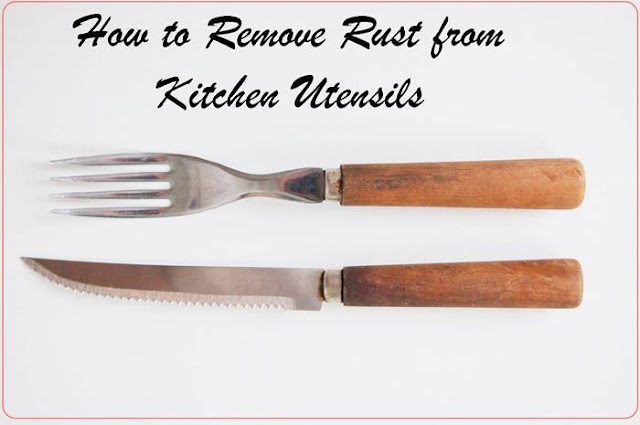Having rusty utensils is very unpleasant. You can’t use them to serve food and the last thing you would want to do is expose them to your guests! They’re not only unsightly but you also run the risk of contaminating your food.
What is Rust?
Rust is an iron oxide formed when iron or an alloy of iron (like steel) is exposed to oxygen and moisture for a long period of time. The rust forms when iron undergoes oxidation.
If chloride ions are present in the moisture, as is the case with salt water, oxidation is likely to occur much faster. This is the reason why a lot of rust is found on iron items near saltwater bodies.
How to Remove Rust from Kitchen Utensils
All your utensils should be free from rust. This includes cutlery (spoons, forks, and knives), plates, cooking pots, and any metallic mugs.
So what should you do if you notice some rust cropping up on your beautiful set of kitchen items?
For starters, avoid using chemicals to remove the rust! This is not only harmful to your health due to the possibility of contamination, but it can also lead to more corrosion of the utensil.
1. Use salt & lemons
This is a cheap method of removing rust from kitchen utensils. The 2 cleaning materials to use are readily available in your kitchen and are natural products. So you don’t have to worry about using toxic chemicals on your utensils.
The amount of salt to use will depend on the area you want to clean; the bigger the area to remove rust, then the higher amount of salt to use & vice versa.
You’ll need a half lemon for this procedure.
Put some of the salt on the half lemon and use it as a scrubbing pad. Scrub the area of your pans or cutlery with rust until it becomes clean. If the salt disappears before all the rust comes off, add more salt to the lemon and continue scrubbing.
An alternative procedure would be to sprinkle some of the salt onto the area covered with rust & squeeze the half lemon over the salt. Then let this mixture sit for 1-2 hours. Scrub the area with the lemon rind until the rust is gone.
Once you’re done, let it sit for a few minutes then wash it clean. Let it dry completely until all moisture is gone. Then using a kitchen brush, apply a little oil onto the utensil and store it away.
2. Use baking soda
With this method, you’re going to need a few tablespoons of baking soda and coarse scrubbing pads. Baking soda is non-abrasive and will gently lift the rust stain from the utensil.
Similar to the previous method discussed above, the amount of baking soda to use will depend on the area covered with rust that needs to be cleaned.
First, mix the baking soda with a little warm water. You only need a little water to make a paste!
Rub the baking soda paste on the utensil covered with rust using the scrubbing pad. Scrub gently until all the rust is gone. Rinse and dry the utensil until there is no more moisture.
3. Use white vinegar
With this method, you’ll need enough white vinegar to soak the kitchen utensil.
The first step is to gently scrub off as much rust from the utensil as possible.
Next, pour the white vinegar into a small bucket and submerge the item to be cleaned. Soak it overnight.
The next day, remove the item from the solution and scrub it using a scouring pad. If there is still too much rust, add a little baking soda or coarse salt to the scouring pad and continue scrubbing until all the rust is gone.
Conclusion:
An important final step is to apply some cooking oil on your cleaned utensils and brush it all over to prevent rust from forming again.
However, the best way to prevent rust from forming is to take very good care of your kitchen utensils. Dry them thoroughly after cleaning to ensure there is no water left on them before putting them away in storage. Remember that rust is formed due to extended exposure to moisture & oxygen.
With rust-free and presentable tableware, you will ensure that your family eats safe food, and you won’t feel embarrassed anytime your guests suddenly show up to your dinner table.







